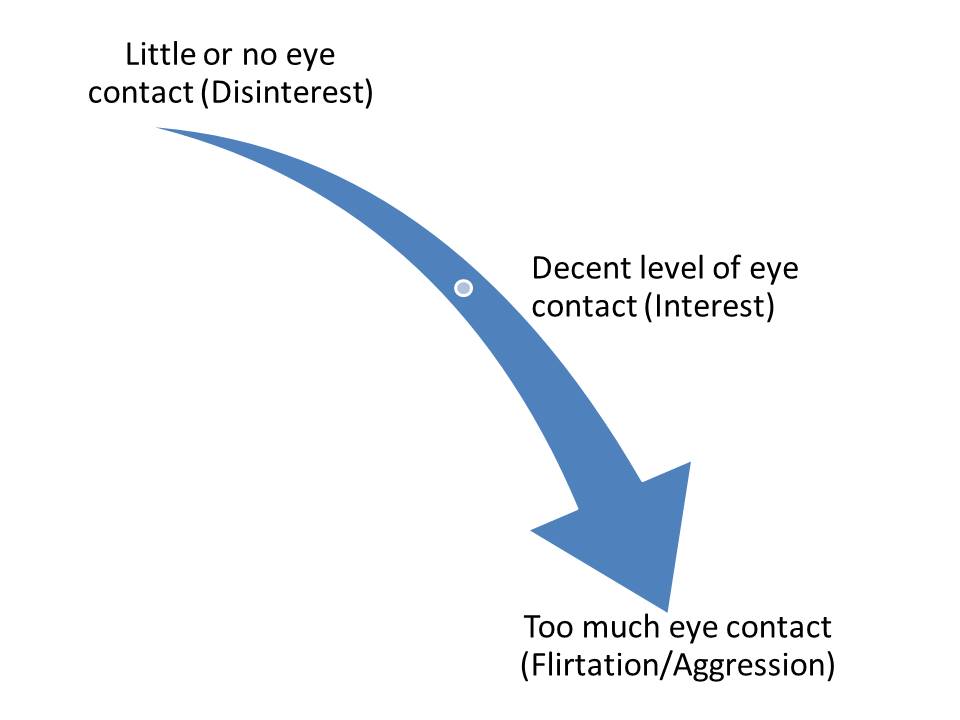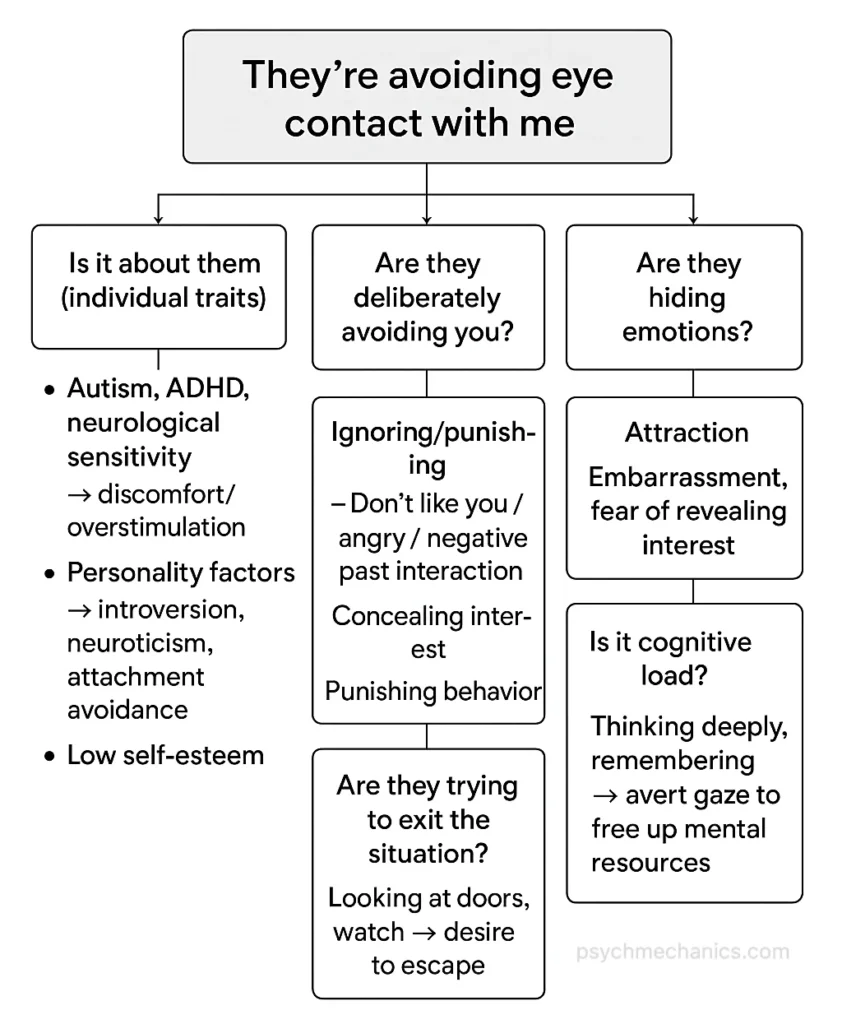In body language, the rule of thumb is that our body turns to where we want to go and what we want to engage with. The same applies to the eyes, which are a body part, after all. Generally, we turn our eyes to where our body wants to go and what we want to engage with.
Hence, when a person avoids eye contact, it likely means they don’t want to engage with what’s in front of them or they want to engage with something else. This desire for disengagement with an object is the core, meta-reason behind most instances of avoiding eye contact.
When you notice someone avoiding eye contact, ask yourself:
“Why do they want to disengage?”
Then look at their accompanying body language signals and the context of the situation to narrow down the reason. It’s tempting to conclude they don’t like you. So I want you to focus on the ‘desire for disengagement’ first and then explore the specific reason for that desire.
People like mutual gaze
Being the social species we are, we like it when others make eye contact with us. It makes us feel connected and included. It builds trust and connection. When we look at someone and they look at us, we feel good.1Jarick, M., & Bencic, R. (2019). Eye contact is a two-way street: Arousal is elicited by the sending and receiving of eye gaze information. Frontiers in Psychology, 10, 1262.
When you make eye contact with someone, you’re communicating:
“I see you and recognize your existence. You’re important to me and I want to connect with you. Let’s engage.”
The desire to feel important, valued, and wanted in humans is strong. As a result, those who make eye contact in social interactions are perceived positively. They’re seen as attractive, interested, competent, socially skilled, having good mental health, credible, and dominant.2Kleinke, C. L. (1986). Gaze and eye contact: a research review. Psychological bulletin, 100(1), 78.
In contrast, avoiding eye contact makes them feel you’re excluding them.3Wirth, J. H., Sacco, D. F., Hugenberg, K., & Williams, K. D. (2010). Eye gaze as relational evaluation: Averted eye gaze leads to feelings of ostracism and relational devaluation. Personality and Social Psychology Bulletin, 36(7), 869-882. You’re seen as shy, socially anxious, deceptive, and less sincere.4Larsen, R. J., & Shackelford, T. K. (1996). Gaze avoidance: Personality and social judgments of people who avoid direct face-to-face contact. Personality and individual differences, 21(6), 907-917.
Too much of a good thing = bad
There’s also such a thing as making too much eye contact. Little to no eye contact is almost always perceived negatively, while too much eye contact can be seen as either positive or negative, depending on the person and the situation.
If you have a good relationship with someone, you’re allowed to make a lot of eye contact. But do the same with a stranger, and you’re likely to come across as creepy. This is because there can be two basic reasons for wanting to engage with someone- either you want to have a positive or a negative interaction. Negative interaction, such as asserting dominance and/or fighting.
Hurting someone also requires engagement. This is why, when people show anger or aggression, they usually stare, communicating:
“I want to engage with you and harm you.”
Hence, a stare from a total stranger makes you feel unsafe. It signals a desire for negative engagement on their part. However, if your crush stares at you, you feel good because it signals, or at least you want to believe it signals, a desire for positive engagement.

Reasons for not making eye contact
Given the benefits of making eye contact, why do people avoid it when they shouldn’t? The biggest reason is social anxiety. There are other reasons, too. Let’s first tackle those before we can dig into social anxiety.
1. Individual traits
People with autism and other neurological conditions like ADHD avoid making eye contact because it’s uncomfortable for them. It causes overstimulation in specific brain regions. So they resist making eye contact to prevent discomfort and pain.5Hadjikhani, N., Johnels, J. Å., Zürcher, N. R., Lassalle, A., Guillon, Q., Hippolyte, L., … & Gillberg, C. (2017). Look me in the eyes: constraining gaze in the eye-region provokes abnormally high subcortical activation in autism. Scientific Reports, 7(1), 1-7.
Those high on attachment avoidance, introversion, and neuroticism are also less likely to make eye contact. Low self-esteem also contributes to making less eye contact.
2. Deliberate ignoring
When someone wants to deliberately ignore you, they’ll avoid looking into your eyes. Possible meta-reasons for this:
- They don’t like you
- They’re angry with you
- Your last interaction with them was negative
- They’re concealing interest
- They’re punishing you
Showing superiority
People who show superiority by not looking at you are essentially communicating:
“You’re so below me I don’t even want to engage with you.”
They’re often rightly perceived as being ‘full of themselves’. They might carry an air of arrogance about them. They don’t deem you worthy of engagement.
3. Showing inferiority
Making eye contact with someone is a way of treating them as your equal. Superior people avoid it for good reason, and so do inferior people. Imagine a subject speaking to a king. What comes to mind? Probably a person with a hunched posture, talking with fear, and avoiding eye contact by looking down, right?
Even today, in some cultures, inferiors don’t make eye contact with superiors as a sign of respect, effectively communicating:
“I’m not at your level. I’m beneath you.”
4. Hiding interest and attraction
Eyes make up a significant piece of the pie of facial expressions signaling. We communicate our emotional states through our eyes. It’s not for nothing that they’re called the windows to the soul. So, avoiding eye contact is a good way to hide our emotions. When a person is interested in someone, they often feel embarrassed to communicate that interest. Hence, not making eye contact is a great way to hide attraction.
When someone likes you, they want to make eye contact with you, but can’t for fear of revealing interest. But they will occasionally make eye contact. They’ll move from making eye contact to not making eye contact, like a pendulum, or give you sideways glances.
On the other hand, if they don’t want any positive engagement with you at all, they will make no eye contact or very little.
5. Desire to escape
Avoiding eye contact can signal a desire to escape a situation. For instance, when someone is talking to you, and you notice they’re continually looking at their watch or at the door, you know they want to leave. Looking at the door is the most straightforward example of ‘eyes go where the body wants to go’.
6. Disgust and fear
Disgust and fear-evoking stimuli make us want to disengage. Averting one’s eyes when watching a gory movie is a good example of this. So is not wanting to look at someone who’s behavior is morally repulsive to you. People tend to avoid looking at high-status people they’re intimidated by, as explained above. The same goes for being too afraid to make eye contact with your crush.
7. Having to think deeply
Making eye contact takes a good chunk of our mental resources. If we want to carry out a complex cognitive task, we avert our gaze to free up our mental resources. For instance, when someone has to think deeply or remember something, they’re likely to avert their gaze. It’s a way to disengage from the environment and engage with the depths of one’s own mind.6Glenberg, A. M., Schroeder, J. L., & Robertson, D. A. (1998). Averting the gaze disengages the environment and facilitates remembering. Memory & cognition, 26(4), 651-658.
Crazy how we can look at the world, and into ourselves, this way.
8. Hiding deceit
There’s a lot of debate on whether avoiding eye contact means someone is lying. Think of it this way: Those who have something to hide can’t face those they’re hiding something from. While people who lie can have shifty eyes and trouble looking at you, it could be because of other reasons, like nervousness and anxiety in a high-pressure situation like an interrogation.
Sometimes, liars will make deliberate eye contact because they know that lying is often associated with gaze aversion. They want to appear confident in their lie, convince the interviewer of it, and check if their lie is believed.7Mann, S., Ewens, S., Shaw, D., Vrij, A., Leal, S., & Hillman, J. (2013). Lying eyes: Why liars seek deliberate eye contact. Psychiatry, Psychology and Law, 20(3), 452-461.
Therefore, as with many other body language signals, it’s prudent to rely on multiple points of data before concluding that someone’s telling a lie.

9. Social anxiety
Social anxiety is perhaps the most common reason people avoid making eye contact. Why do socially anxious people disengage from those around them? It boils down to the fear of rejection- the fear that others will judge them negatively.8Schneier, F. R., Rodebaugh, T. L., Blanco, C., Lewin, H., & Liebowitz, M. R. (2011). Fear and avoidance of eye contact in social anxiety disorder. Comprehensive psychiatry, 52(1), 81-87.
Being the social species that we are, we want to be judged positively and included, not rejected by our group members. Socially anxious people don’t feel anxiety when they’re in a group that loves, accepts, and includes them (e.g., their family). What’s interesting about social anxiety is that it’s triggered chiefly in novel social situations such as dating, meeting strangers, attending job interviews, etc. In other words, social anxiety is triggered in situations where a person can’t be sure they will be included, accepted, or liked.
What purpose does social anxiety serve?
If we go back to the evolutionary roots of social anxiety, it’s really just a way to display submissive behavior and avoid attack from a potential aggressor.
Avoiding gaze, turning away, behavioral inhibition, and the classic fear grin are all submissive behaviors that low-ranked primates display to dominant primates.9Gilbert, P. (2001). Evolution and social anxiety: The role of attraction, social competition, and social hierarchies. Psychiatric Clinics, 24(4), 723-751.
Avoiding eye contact in novel social situations also enables socially anxious individuals to reduce their fear. Ethologists point out that this ‘cut-off’ behavior is an automatic response to avoid signals that can trigger fear and arousal.10Dixon, A. K. (1998). Ethological strategies for defence in animals and humans: their role in some psychiatric disorders. British Journal of Medical Psychology, 71(4), 417-445.
Hence, this response is automatic and is controlled by a deeper part of the brain. While a socially anxious person may consciously know that coming across as socially anxious will not help with their inclusion in the group, they can’t seem to control it. Not getting dominated, attacked, or killed by aggressors is apparently a greater priority for the mind than seeking social acceptance. It makes sense because the former has higher survival value.

